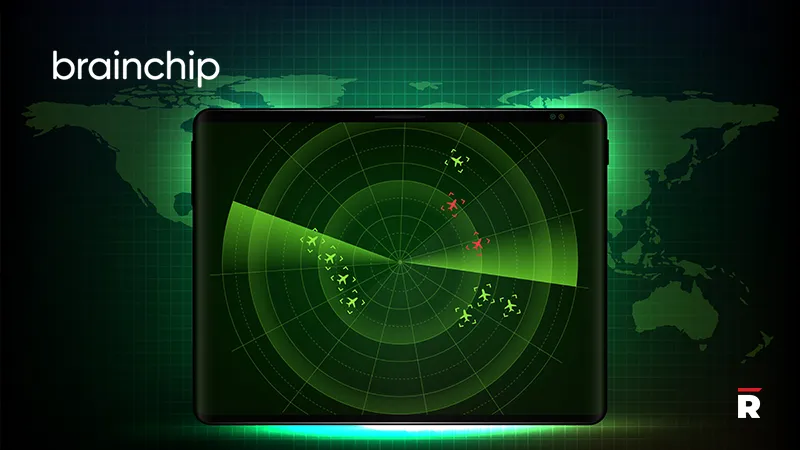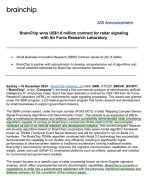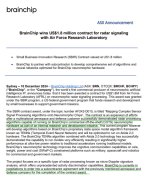One thing is indisputable, if it were not for Joe Guerci, we would not have won this contract.
An interview from March this year is well worth a listen.
Here are a couple of snippets from the transcript, that everybody should read and take note of.
Joe Guerci with some help from his friends at Raytheon made this happen.
Dr. Joseph Guerci

fromthecrowsnest.transistor.fm
And you had a slide in
your webinar presentation
that we were talking about
the relationship with AI,
and there's an aspect to AI
that's using neuromorphic
computing and neuromorphic chips,
and we were talking about this.
This concept just blew my mind,
because I really never
heard the term before.
So I wanted to kind of,
I wanna ask you to talk
a little bit about this.
What is this piece of the puzzle,
and what does it it hold
in terms of the future
for artificial intelligence,
and then feeding into
cognitive radar and EW?
- So cognitive radar, EW,
live and die by embedded systems, right?
They don't have the luxury
of living in a laboratory
with thousands of acres
of computers, right?
They have to take all their
resources on a plane or at UAB
or whatever platform and go into battle.
And so to really leverage the power of AI,
you need to implement them
on efficient embedded computing systems.
Right now, that means FPGAs, GPUs,
and those things are,
when all is said and done,
you know, all the peripherals required,
the ruggedization, the MIL-SPEC,
you're talking kilograms and kilowatts.
And as I pointed out,
there is a rather quiet
revolutionary part to AI
that's perhaps even bigger
than all the hullabaloo about ChatGPT,
and that's neuromorphic chips.
So neuromorphic chips don't implement
traditional digital flip-flop
circuits, things like that.
Essentially they actually, in silicon,
create neurons with interconnects.
And the whole point of a neural network
is the weighting that goes
onto those interconnects
from layer to layer.
And the interesting thing about that
is you've got companies like
BrainChip in Australia, right,
that is not by any stretch
using the most sophisticated foundry
to achieve ridiculous line lists
like conventional FPGAs and GPUs do.
Instead it's just a
different architecture.
But why is that such a big deal?
Well, in the case of BrainChip
as well as Intel and IBM,
these chips can be the
size of a postage stamp.
And because they're implementing
what are called spiking
neural networks, or SNNs,
they only draw power when
there's a change of state,
and that's a very short amount of time,
and it's relatively low-power.
So at the end of the day,
you have something the
size of a postage stamp
that's implementing a
very, very sophisticated
convolutional neural network solution
with grams and milliwatts
as opposed to kilograms and kilowatts.
And so to me, this is the revolution.
This is dawning. This is the
thing that changes everything.
So now you see this little UAV coming in,
and you don't think for a second
that it could do, you know,
the most sophisticated
electronic warfare functions,
for example.
Pulse sorting, feature
identification, geolocation,
all these things that require,
you know, thousands of lines of code
and lots of high-speed embedded computing,
all of a sudden it's
done on a postage stamp.
That's the crazy thing.
And by the way, in my
research we've done it.
we've implemented pulse, the interleaving,
we've implemented, you know, ATR,
specifically on the BrainChip
from Australia, by the way.
So really quite amazing.
And this technology I'm talking
about, neuromorphic chips,
that's available to the world.
I mean, BrainChip is
an Australian company.
There's no ITAR restrictions, so.
- Well, and also I think it speaks
to the multidisciplinary
approach to technology today.
I mean, the neuromorphic chip,
I mean, it has military applications
you can obviously use it for,
but, I mean, you're gonna find this
in all various sectors
of an economy and society
and what we use in everyday
life, and so, you know-
- So Ken, let me just say
that the neuromorphic chip
that BrainChips makes from Australia
had nothing to do with electronic warfare.
It's designed to do image processing.
So one of the things we had to overcome
was take our electronic warfare I/Q data,
in-phase and quadrature
RF measurement data,
and put it into a format to
make it look like an image
so that the BrainChip
could actually digest it
and do something with it.
So you're absolutely right.
I mean, these chips are
not being designed for us
in the electronic warfare community,
but they're so powerful
that we were still able to get it to work.
Imagine if they put a little effort
into tailoring it to our needs.
Then you have a revolution.








